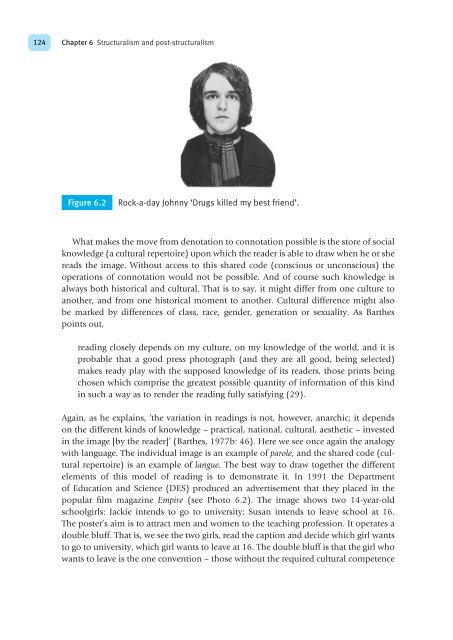Cultural Theory and Popular Culture
Cultural Theory and Popular Culture
Cultural Theory and Popular Culture
Create successful ePaper yourself
Turn your PDF publications into a flip-book with our unique Google optimized e-Paper software.
124<br />
Chapter 6 Structuralism <strong>and</strong> post-structuralism<br />
Figure 6.2 Rock-a-day Johnny ‘Drugs killed my best friend’.<br />
What makes the move from denotation to connotation possible is the store of social<br />
knowledge (a cultural repertoire) upon which the reader is able to draw when he or she<br />
reads the image. Without access to this shared code (conscious or unconscious) the<br />
operations of connotation would not be possible. And of course such knowledge is<br />
always both historical <strong>and</strong> cultural. That is to say, it might differ from one culture to<br />
another, <strong>and</strong> from one historical moment to another. <strong>Cultural</strong> difference might also<br />
be marked by differences of class, race, gender, generation or sexuality. As Barthes<br />
points out,<br />
reading closely depends on my culture, on my knowledge of the world, <strong>and</strong> it is<br />
probable that a good press photograph (<strong>and</strong> they are all good, being selected)<br />
makes ready play with the supposed knowledge of its readers, those prints being<br />
chosen which comprise the greatest possible quantity of information of this kind<br />
in such a way as to render the reading fully satisfying (29).<br />
Again, as he explains, ‘the variation in readings is not, however, anarchic; it depends<br />
on the different kinds of knowledge – practical, national, cultural, aesthetic – invested<br />
in the image [by the reader]’ (Barthes, 1977b: 46). Here we see once again the analogy<br />
with language. The individual image is an example of parole, <strong>and</strong> the shared code (cultural<br />
repertoire) is an example of langue. The best way to draw together the different<br />
elements of this model of reading is to demonstrate it. In 1991 the Department<br />
of Education <strong>and</strong> Science (DES) produced an advertisement that they placed in the<br />
popular film magazine Empire (see Photo 6.2). The image shows two 14-year-old<br />
schoolgirls: Jackie intends to go to university; Susan intends to leave school at 16.<br />
The poster’s aim is to attract men <strong>and</strong> women to the teaching profession. It operates a<br />
double bluff. That is, we see the two girls, read the caption <strong>and</strong> decide which girl wants<br />
to go to university, which girl wants to leave at 16. The double bluff is that the girl who<br />
wants to leave is the one convention – those without the required cultural competence
















